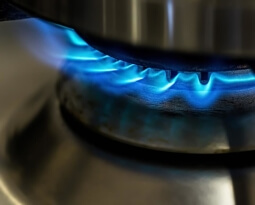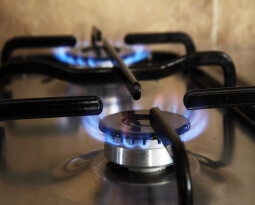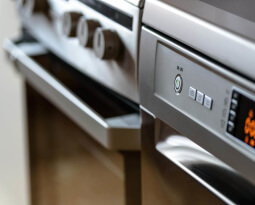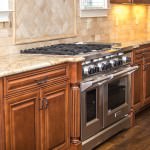We know that having a broken stove is a frustrating experience, that’s why we’re here to help you repair it and get you cooking again quickly. Do-it-yourself stove repairs can be easy, provided you can diagnose the problem and get the appropriate part if necessary. In this series you’ll find common broken stove symptoms. If your stove is experiencing one of them, give our experts a call to discuss the best course of action.
Stove will not turn on
If your broken stove will not turn on, start by examining a few key elements such as the fuses, infinite switch, surface element, bake and broil element and the stove burner igniter.
Fuse: If your stove has internal fuses, a wiring or component problem could have caused a fuse to blow. A blown fuse is an indication that a component has shorted or failed, and the problem will need to be corrected. Most stoves that use fuses will have an indication of the circuits that are affected by a particular fuse. If an stove fuse has blown, then you should inspect the stove element and the associated wiring to determine the cause before replacing the fuse. Do not change the rating of the fuses. The same will apply to a fuse labeled for a surface burner. Disconnect power from the range or stove before attempting service
Broil Element: The broil element is the heating element that is found at the top of the stove and produces a very high heat for broiling. If the broil element isn’t working, you should first do a visual inspection for signs that the element has blistered or separated. If the element appears normal then you can check for continuity with a multi-meter. Remove power from the appliance before performing this test. Remove the back panel and locate the terminals for the broil element and inspect the terminals and wires for signs of overheating or damage.
If there is no continuity then the element will need to be replaced. If the wires are damaged then they will need to be repaired. If the element is ok then you will need to check the broil circuit to determine the cause. This involves live voltage checks and should only be performed by qualified persons. Components to check include fuses, if the range is equipped, and stove control thermostat or electronic control.
Bake Element: The bake element is the heating element that is found at the bottom of the stove. Most electric stoves use both the bake element and the broil element in a bake cycle, with the bake element performing 90% of the heating. If the bake element isn’t working, the stove may not heat. To help determine if the bake element is defective you should first do a visual check. If the element is blistered or separated then it should be replaced. If the element appears to look normal, then turn the stove on to a bake function for a minute and then turn it off.
Check the element for signs of heating and if it is still cold then it may be defective. Disconnect the power and then remove the back panel. First check the wires as they may have become loose or corroded. If the element appears to be fine visually, test it for continuity with a multi-meter. If the element is burned or no longer has continuity, it will need to be replaced. If the element is ok then you will need to check the bake circuit to determine the cause. This involves live voltage checks and should only be performed by qualified persons. Components to check include fuses, if the range is equipped, and stove control thermostat or electronic control.
Surface Burner: Surface burners are typically either a coil type, solid type or a ribbon coil as used in smooth top ranges. All of these consist of a heating wire that uses electric current to produce heat. Coil type elements can be checked for continuity by removing them from the terminal block and testing them with a multi-meter.
You should also inspect the terminal ends for signs of heat damage or corrosion, and if present, you should replace the terminal block or receptacle at the same time. You will need to remove power from the range to change the terminal block. Solid elements and smooth top elements require raising or removing the main top to gain access. You will need to remove power from the range before lifting the main top. Continuity can then be checked with a multi-meter, once you have removed the wires from the element terminals.
Temperature Sensor: On modern electronic control ranges, the stove temperature sensor is the part that regulates the stove temperature. If it is not working properly it could be the reason why the range or stove won’t start. This part can be found inside the stove on the rear wall near the top. Most modern stoves will display a fault code if the stove sensor is at fault. If you think the sensor may be the issue you can check the resistance with a multi-meter but will need to know the correct resistance of the sensor at room temperature. Remove power from the appliance before performing this test.
Infinite Switch: The infinite switch on the control panel controls the power to each surface element. If you have no heat at an element and the element and terminal block check ok, then you may have a defective infinite switch. Disconnect power to the range and remove the console back panel. Locate the switch and check for overheated wires or faulty terminals first. Test the switch’s contacts for continuity with a multi-meter. If defective, replace the switch. If the infinite switch does not appear to be defective, then you should check for proper voltage to the switch. This is a live high voltage test and should only be performed by qualified persons.
Electronic Control Board: Most modern stoves use an electronic control board to control the stove functions. These models will use the control board to operate the stove safety valve on a gas range or stove, and the bake and broil elements on an electric range or stove. If there is no power to the igniter circuit, or the element circuits, then you should check the control board to verify that there is power at the appropriate output relay. These are live voltage checks and should be performed by qualified persons only. If there is no output voltage then the control should be replaced.
Safety Valve: The stove safety valve (also called the gas valve) is the part that ensures that gas is not released until the igniter has reached the correct temperature needed to ignite the gas. While this part can fail, it is uncommon. If the hot surface igniter does not glow you should first verify that you have voltage to the circuit. This is a live voltage check and should be performed by a qualified person. If voltage is lost at the valve terminals then you should verify the continuity of the bi-metal in the valve using a multi-meter.
Stove Burner Ignition: The stove burner igniter commonly known as the hot surface igniter is used in modern gas stove burners to open the gas valve and to ignite the gas. As the igniter draws electric current it will heat to a high temperature and glow, as well as cause the bi-metal in the stove safety valve to warp and open the valve releasing the gas to be ignited. This sequence normally takes about a minute. Igniters come in both flat and round styles and are very fragile. If the burner does not light then you should check the igniter first. If the igniter does not glow at all, then check for power to the circuit. This is a live voltage check and should be performed by a qualified person. If power is present then the igniter may be open circuit and can be checked for continuity with a multi-meter. If the igniter is glowing, but the burner is not lighting, the igniter may be weak and still be at fault because it requires a certain amount of current draw to open the valve. This check requires the use of an amp meter and should be performed by a qualified person. If the igniter is defective then it must be replaced.
Other Repair Parts: These are the most common parts that can cause your broken stove to not turn on, but there are other parts that could be at fault. If you are unable to fix your broken stove, give our experts a call to discuss the issue. We might be able to help you diagnose problem and order you the right parts so you can get back to cooking as quickly as possible.







